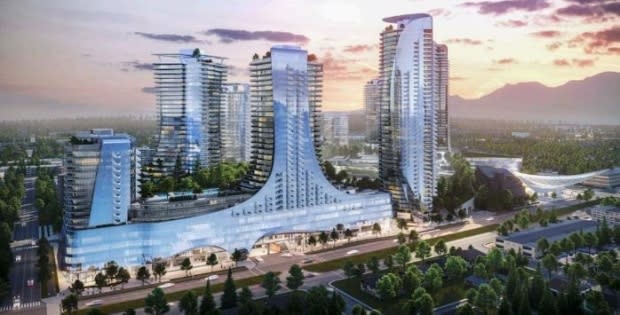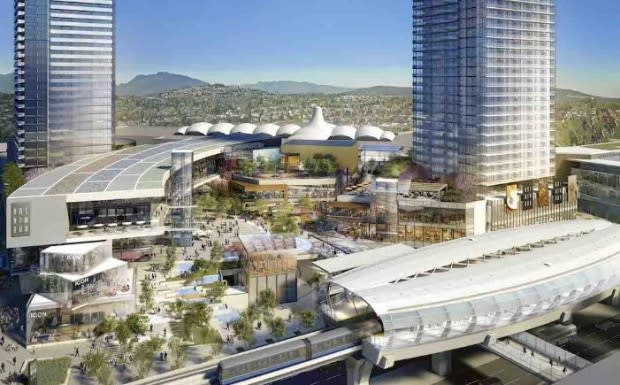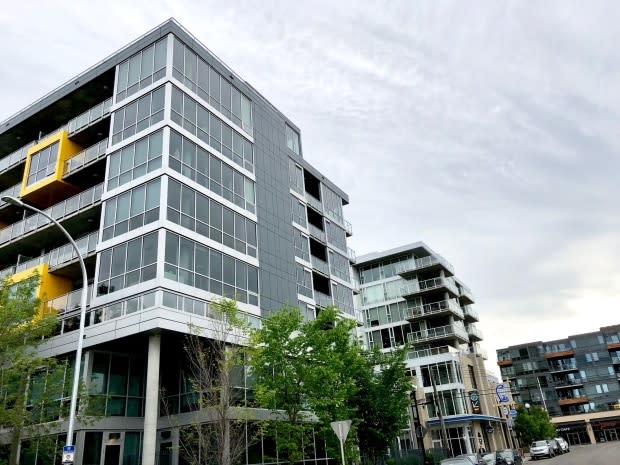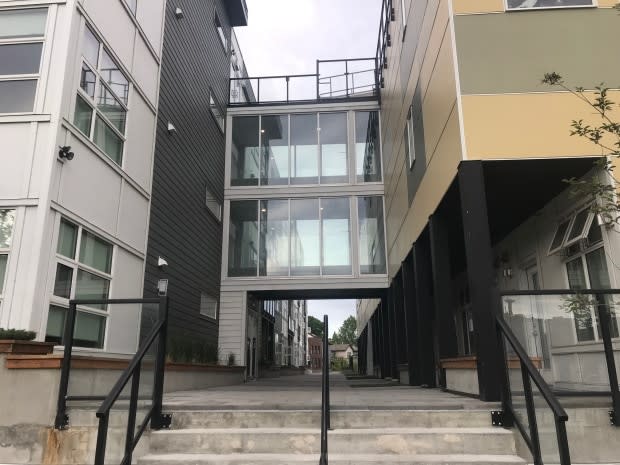OPINION | Calgary lags behind on transit-oriented development

Originally published on June 13, 2019.
One of the things I was most impressed with during my month-long visit to Vancouver earlier this year was the amazing transit-oriented development (TOD) that has happened in that city over the past 15 years.
It got me thinking that, if the future of urban living in North American cities is linked to creating vibrant, dense communities next to LRT stations, why isn't Calgary fast-tracking TOD development next to existing LRT stations, rather than expanding the LRT to the north and southeast edges of the city?
What is TOD?
Transit-oriented development (TOD) is commonly defined as high-density, mixed-use development within a 15-minute walk of a transit station. TOD provides a range of benefits including increased transit ridership, reduced regional congestion and pollution, and healthier, more walkable neighbourhoods.
TOD neighbourhoods have a mix of affordable and market-rate housing, as well as a mix of commercial amenities: grocers, restaurants, cafes, shops, fitness studios and professional services.
Calgary lags behind
I was gobsmacked by the numerous highrise residential towers next to the Metrotown SkyTrain station and Metrotown Mall in Burnaby. I couldn't help but wonder why there hasn't been major residential development next to Calgary's Chinook and Anderson LRT stations, as they have many of the same conditions as Metrotown. Both have major malls and major roads nearby. The Metrotown SkyTrain didn't open until 1985, while Chinook and Anderson opened in 1981.
The more I rode Vancouver's SkyTrain, the more impressed I was with how almost every station is surrounded not only by mid-rise and highrise residential, but with grocery stores and other amenities to create an urban village.
By clustering a large share of the region's population, employment growth, new major public spaces, community facilities and cultural amenities in locations well served by public transit, Vancouver has become a leader in the development of walkable, transit-oriented communities.

Metro Vancouver has nine major town centres and 18 smaller ones, each with its own LRT station.
Recently, the Vancouver website Daily Hive published a list of 21 mega transit-oriented developments in the works for the Lower Mainland. These are not just one or two towers next to an LRT station, but entire new communities like Calgary's East Village, University District and Currie. Some of the plans are so big they include four separate LRT Stations.
While Calgary has its share of 21st century TOD happening — Bridgeland, East Village, Brentwood and Dalhousie — we are lagging behind cities like Vancouver and Portland, which built their LRT systems after ours.
Upon arriving home, I contacted several planners and developers to try to understand why Calgary hasn't seen more TOD development.
I was especially curious why TOD along the south leg — Chinook, Anderson, Stampede Park, Manchester (39th Avenue S.E.) — hasn't happened, given they are all surrounded by underutilized land, perfect for mixed-use TOD development.
What I learned
I first met with David Couroux, the City of Calgary's TOD planner, and he informed me that the biggest barrier to TOD development in Calgary is funding for the infrastructure needed to undertake it, everything from upgrading water and sewer systems, improving sidewalks, creating new parks and integrating bus services with trains to create transit hubs.
He said with a smile, "Creating policy and plans is cheap; it is the implementation that is expensive."
Indeed, the city often gets bogged down in creating endless policy and plans that frequently act as a barrier to development, instead of an incentive.
That being said, Couroux noted Calgary has seen significant new TOD development over the past 15 years.
He pointed out that in 2009, the city approved the Hillhurst Sunnyside ARP Transit Oriented Development Plan and, almost immediately, mid-rise developments began to happen: St. John's on Tenth, Ven, Pixel, Lido and Kensington, with the new Memorial Drive and Annex condos now under construction and Theodore being marketed.

Couroux thinks The Bridges is perhaps the best example of TOD in Calgary.
It has proceeded slowly but steadily, and there are only two or three parcels of land left to develop. It features all the characteristics of TOD one would expect: higher density, mixed-use development, a pedestrian focus to the mobility network, parks, a main street and an upgraded public realm.
Anderson station remains an unrealized opportunity, as do other south line station areas, such as Heritage and Southland. The requirement to maintain park-and-ride spaces adds significant costs to the redevelopment of these sites for TOD, because they would need to be accommodated by expensive underground parkades.
Couroux is optimistic that redevelopment around Brentwood and Dalhousie stations and long-awaited projects at Anderson and Heritage stations will get off the ground in the near future.
Developer frustrations
Joe Starkman, the president of Knightsbridge Homes, expressed in a telephone chat his frustration with the city's focus on creating plans and policy rather than implementation.
Starkman, who is responsible for the playful yellow, red and green condo towers at the Brentwood station, says he wouldn't do TOD again. Why? Because it takes too long to get approvals — it took four years and $1 million to get University Village approved.
He said he wouldn't go to the city for a "rezoning" today as it is too costly, and there is too much uncertainty when it comes to getting plans approved.
He pointed out that Westbrook station's "Request For Proposals" was 400 pages long, making it too arduous to review and understand.
In his opinion, the red tape at city hall is getting worse, not better. Starkman is also frustrated by what he calls the city's double talk.
"The city claims to want more density near transit corridors, but when a developer comes to them with a proposal, instead of being fast-tracked, it gets bogged down in endless reviews and community engagement," he said.
"It is often city roads and water engineers who are barriers to TOD development, not the planners," he added.
Other developers have shared similar experiences with me over the years.

Insights from a TOD planner
I then contacted Gary Andrishak, the director of the IBI Group in Vancouver, who has over 30 years experience in TOD planning in North America, to get his insights into Calgary's TOD history and future.
Given that he has been involved in the development of many of Calgary's TOD plans (including the new Green Line), he knows our situation well.
Andrishak was indeed insightful and forthright in his comments.
He said upfront that comparing Calgary to Vancouver is unfair, as "Vancouver is as good as it gets when it comes to TOD development in North America, and it is a very different city than Calgary.
"A city that can sprawl, will sprawl," he added — which is Calgary's problem, as there are no barriers to sprawl, like the ocean or mountains in Vancouver.
One of the biggest failures in Calgary, he said, is that council hasn't linked transportation and land use planning.
For example, all of the land along transit corridors and near LRT stations should be zoned for mixed-use, multi-family development to streamline TOD development.
He also suggested that the city has a history of treating rapid public transit as a utility rather than "the glue that can hold a city together. Calgary lost a generation of TOD over cities like Portland, who saw the synergies of building density adjacent to transit back in the '90s."
One of the other barriers to good TOD development in Calgary is the fact that too much TOD development is still negotiated between city councillors and developers, shutting out the planners, which leads to complications later.
He also noted most of Calgary's TOD developments are not well designed when it comes to the mix of uses and the incorporation of mid-rise buildings.
Andrishak thinks Calgary has a tendency "to go too big, too quickly." He said that in Vancouver, developers understand the importance of investing in quality, usable public realms that create a more attractive, walkable pedestrian experience; that is not the case for most developments in Calgary.

With respect to the south leg of the LRT, Andrishak thinks the decision to use the Canadian Pacific Railway right-of-way has resulted in making TOD development difficult, as people simply don't want to live next to heavy rail lines due to noise and safety concerns.
Similarly, the decision to run much of the northwest leg of the LRT up the middle of Crowchild Trail is a barrier, as you need to be able to build right up to the station to have good TOD development. Building LRT lines next to or in the middle of a freeway just doesn't work, in Andrishak's experience.
"The car — no, make that the pickup truck — is still king in Calgary," noted Andrishak. "Calgary has one foot in the city and one in the country; there is still lots of room to grow. You can still see the downtown from the edge of the city, so people think, 'What's the problem?'"
Calgarians love their single-family homes
Not only do Calgarians love their cars and pickups but they also love home ownership and living in single-family homes.
A 2018 survey by Mustel Group for Sotheby's International Realty Canada found "the preference for single-family home ownership (91%) is higher in Calgary than in any other metropolitan area in Canada. In addition, the rate of single-family home ownership is significantly higher than any other city at 74% as the price of home ownership is more accessible in Calgary than other major cities."
Obviously, one of the key factors driving the incredible demand for new condos in Vancouver is the high cost of single-family homes, a situation that is not mirrored in Calgary.
That same Sotheby's study found 78 per cent of Metro Vancouver's young families reported they would like to own a single-family home; however, only 46 per cent actually bought a detached house, with 27 per cent buying a townhome and 27 per cent a condo. The survey also found that 55 per cent of those who don't own a single-family home today have given up any plans to do so.
The fact Calgary has the highest home ownership of any major city in Canada and the most affordable single-family home prices means our market for TOD development, which is exclusively mid- to high-rise multi-family residential, is smaller than in any major city in Canada.
Still, I can't help but wonder if it would be better for municipal, provincial and federal governments to fund infill projects at LRT stations in major cities, instead of constructing new LRT lines.
Rather than taking the LRT out to the edges of Calgary, as we are about to do again with the Green Line, encouraging more development in places like Airdrie, Cochrane and Okotoks and more new edge communities in the city, wouldn't it be better if we invested in the infrastructure needed to create more housing where we already have LRT and bus service?
This column is an opinion. For more information about our commentary section, please read this editor's blog and our FAQ.
Calgary: The Road Ahead is CBC Calgary's special focus on our city as it passes through the crucible of the downturn: the challenges we face, and the possible solutions as we explore what kind of Calgary we want to create. Have an idea? Email us at calgarytheroadahead@cbc.ca.
More stories from the series:

